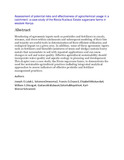| dc.contributor.author | Lalah, Joseph O. | |
| dc.contributor.author | Omwoma, Solomon | |
| dc.contributor.author | Osano, Francis O. | |
| dc.contributor.author | Mukunda, Elizabeth | |
| dc.contributor.author | Shivoga, William S. | |
| dc.contributor.author | Wafubwa, Gaitano | |
| dc.contributor.author | Muyekho, Dolorita | |
| dc.contributor.author | Schramm, Karl-Werner | |
| dc.date.accessioned | 2021-07-09T10:30:35Z | |
| dc.date.available | 2021-07-09T10:30:35Z | |
| dc.date.issued | 2018-05 | |
| dc.identifier.uri | https://doi.org/10.1016/B978-0-12-816155-5.00016-6 | |
| dc.identifier.uri | http://r-library.mmust.ac.ke/123456789/1771 | |
| dc.description.abstract | Monitoring of agronomic inputs such as pesticides and fertilizers in canals, streams, and rivers within catchments and subsequent modeling of their fate and toxicity are useful tools in determination of their efficient utilization and ecological impact on a given area. In addition, some of these agronomic inputs such as fertilizers and biosolids (mixtures of scum and sludge) contain heavy metals that accumulate in soil with repeated applications and can cause changes in soil and water quality. Effective agricultural sustainability should incorporate water quality and aquatic ecology in planning and development. This chapter uses a case study, the Nzoia sugarcane farms, to demonstrate the need for sustainable agricultural practices including integrated analytical approaches to assess indicators of effective pesticide and fertilizer management practices. | en_US |
| dc.language.iso | en | en_US |
| dc.publisher | Science Direct | en_US |
| dc.subject | Assessment ,potential, risks, effectiveness, agrochemical, usage ,catchment, Nucleus, Estate, sugarcane, farms | en_US |
| dc.title | Assessment of potential risks and effectiveness of agrochemical usage in a catchment: a case study of the Nzoia Nucleus Estate sugarcane farms in western Kenya | en_US |
| dc.type | Article | en_US |

